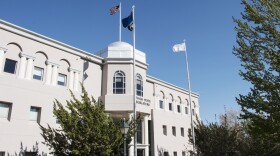About one out of five Nevadans have been fully vaccinated from COVID-19, and nearly a third of the state’s population has received the first dose. It will take many more shots before the state reaches herd immunity — when the population gains protection through vaccination or natural immunity.
To learn more about this, KUNR’s Emilie Rodriguez spoke with Brian Labus, an epidemiologist with Nevada’s COVID-19 medical advisory team.
Emilie Rodriguez: Would you define herd immunity for me and explain why it’s important during the COVID-19 pandemic?
Brian Labus: Well, the idea of herd immunity is that you have a sufficient level of protection in your population that if a disease is introduced, you won’t get an outbreak that flares up and just keeps on going. So you have just a large percentage of the people in your population immune, either through natural disease or through vaccination, that if I start to introduce disease, it keeps running into these dead ends and can’t quickly spread throughout the population. It doesn’t mean that there’s no disease at all. It just means that the population as a whole, the herd, is protected.
Rodriguez: What percentage of Nevadans need to be vaccinated for the state to reach herd immunity?
Labus: Well, if you work out the numbers, it’s somewhere around 70 percent or so, but it’s a little more complicated than that. We can come up with a simple formula that says once we hit that number, we generally have herd immunity. But one of the assumptions of herd immunity is that you have equal population mixing, that every person comes in contact with everybody else, kind of like animals in a field. That’s not how people interact with each other. You have people that group together by their interests and things like that. So you might have a group of people that 100 percent of them are immune, and you might have a group that just refuses to get vaccinated and they have a very low percentage. Even though you have that level of herd immunity in the population, you have pockets of people within that population that could still see a lot of disease.

Rodriguez: Sometimes we say 60 to 70, even in some cases, 90 percent of the population needs to be vaccinated. Why does that number change?
Labus: The calculation that we do is based on a simple number we have reached disease, the basic reproduction number, which is the average number of cases that each case of disease will create. So, if I get COVID, how many people on average will I infect? We don’t know that number exactly, right? We have a bunch of estimates, and if you put it into the formula using different numbers for that, you’re going to get different estimates. So, typically the 60 to 70 percent range is somewhere where you’ll see it, and then we also have to take into account the efficacy of the vaccine.
Rodriguez: If we did reach the point where we vaccinated about 70 percent of Nevadans, how long would immunity last?
Labus: Well, that’s the big question right now. Nobody really knows how long the immunity lasts after vaccination. We know that the response to the vaccine is stronger and likely longer lasting than natural infection, and from what we’ve seen, we know that it protects you for at least six months. That’s something we’ll have to monitor over time, but we just don’t know the answer to the question at that point. We’re trying to learn that, but we just have to let time pass to be able to make that determination.
Rodriguez: In that respect, do the different COVID-19 variants affect the [efficacy] of the vaccine?
Labus: Yes. If you have mutations in the virus that are circulating, you have those different variants that could affect the ability of the vaccine to protect us. It’s not like it makes the vaccine completely ineffective. What it can do is change the ability to protect a little bit. So it weakens the response, but it doesn't completely eliminate the response. What we’ve seen so far, though, is that the vaccine is effective against the strains that were circulating before and these new strains that are circulating as well.
Rodriguez: Right now, vaccinations are available for those 16 and older. Can we still achieve herd immunity by leaving out children?
Labus: Well, herd immunity doesn’t care what age you are. As long as you can be infected and spread the disease, that is part of the equation. One of the vaccine manufacturers did apply for emergency use authorization for age 12 and older for the Pfizer vaccine, so that would allow more people to get vaccinated if that’s approved. And we’re doing studies right now to get down into the youngest of children to see if we can vaccinate them. But that’s something we have to think about. It’s hard to vaccinate 70 percent of your population if 20-something percent is too young to get vaccinated.
Rodriguez: That leads me to my next question. In Nevada, what are the major obstacles that currently hinder herd immunity?
Labus: The biggest obstacle that we’ve had so far is a limited supply of vaccine. We still have more people that want the vaccine than we have doses we can give out. So, right now, that is our biggest challenge. If we had all the doses we need for everybody right now, we could start to deal with those other kinds of issues, but right now, it is simply the fact that we don’t have enough vaccine to vaccinate everybody who wants it. [For] the people who don’t want it, how do we get them into the group that’s vaccinated?
Emilie Rodriguez is a senior at the Reynolds School of Journalism. She is a student reporter with KUNR Public Radio and The Hitchcock Project for Visualizing Science.






